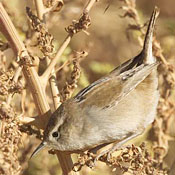Marsh Wren
Cistothorus palustris

Perching

Length: 5 in. (3 cm )
This wren spends all of its life in reeds and aquatic vegetation of marshy areas. Males often have multiple mates, and the nest is a rounded ball attached to reeds and made of grasses. Food consists of insects and commonly the eggs of other bird species nesting in the marsh. During the winter, the nests are used as roosts for the adults. A single male has been recorded singing more than 200 different types of songs.\r\n
The four-digit banding code is MAWR.
Bibliographic details:
- Article: Marsh Wren
- Author(s): Dr. Biology
- Publisher: Arizona State University School of Life Sciences Ask A Biologist
- Site name: ASU - Ask A Biologist
- Date published: 13 Jul, 2017
- Date accessed:
- Link: https://askabiologist.asu.edu/activities/bird/marsh-wren
APA Style
Dr. Biology. (Thu, 07/13/2017 - 15:37). Marsh Wren. ASU - Ask A Biologist. Retrieved from https://askabiologist.asu.edu/activities/bird/marsh-wren
Chicago Manual of Style
Dr. Biology. "Marsh Wren". ASU - Ask A Biologist. 13 Jul 2017. https://askabiologist.asu.edu/activities/bird/marsh-wren
Dr. Biology. "Marsh Wren". ASU - Ask A Biologist. 13 Jul 2017. ASU - Ask A Biologist, Web. https://askabiologist.asu.edu/activities/bird/marsh-wren
MLA 2017 Style
Be Part of
Ask A Biologist
By volunteering, or simply sending us feedback on the site. Scientists, teachers, writers, illustrators, and translators are all important to the program. If you are interested in helping with the website we have a Volunteers page to get the process started.






